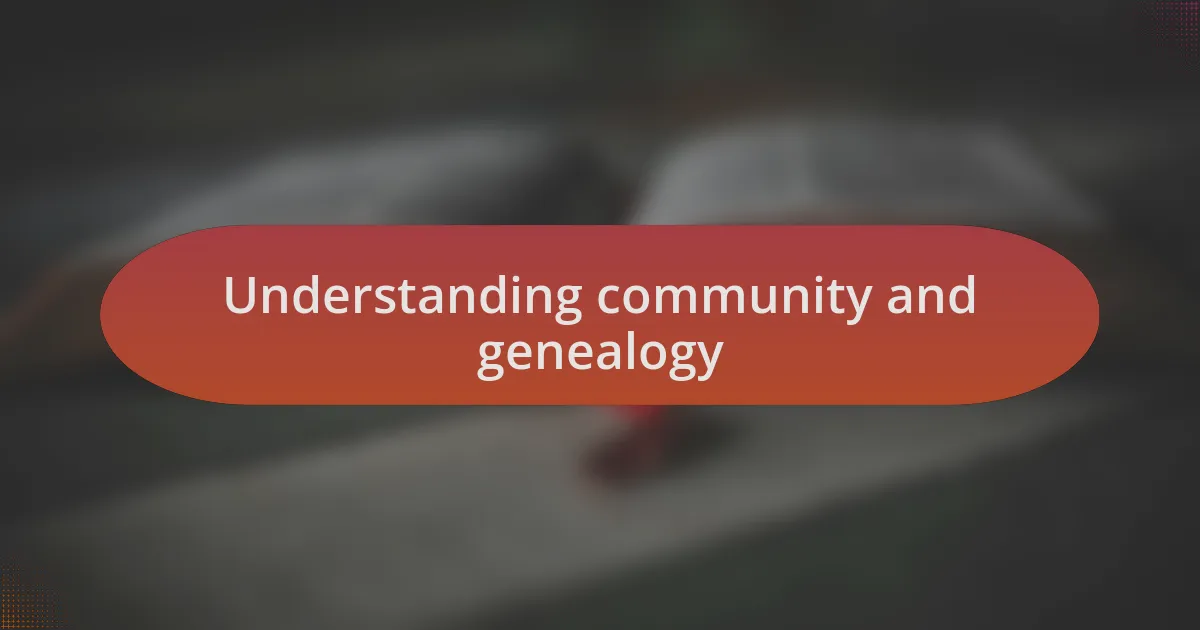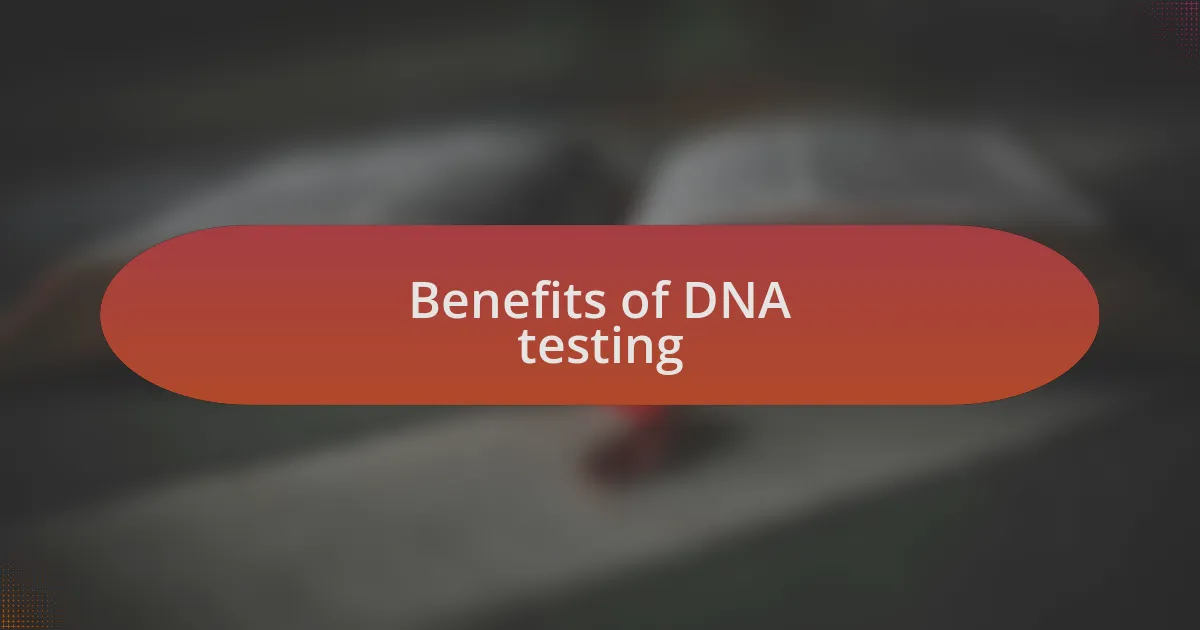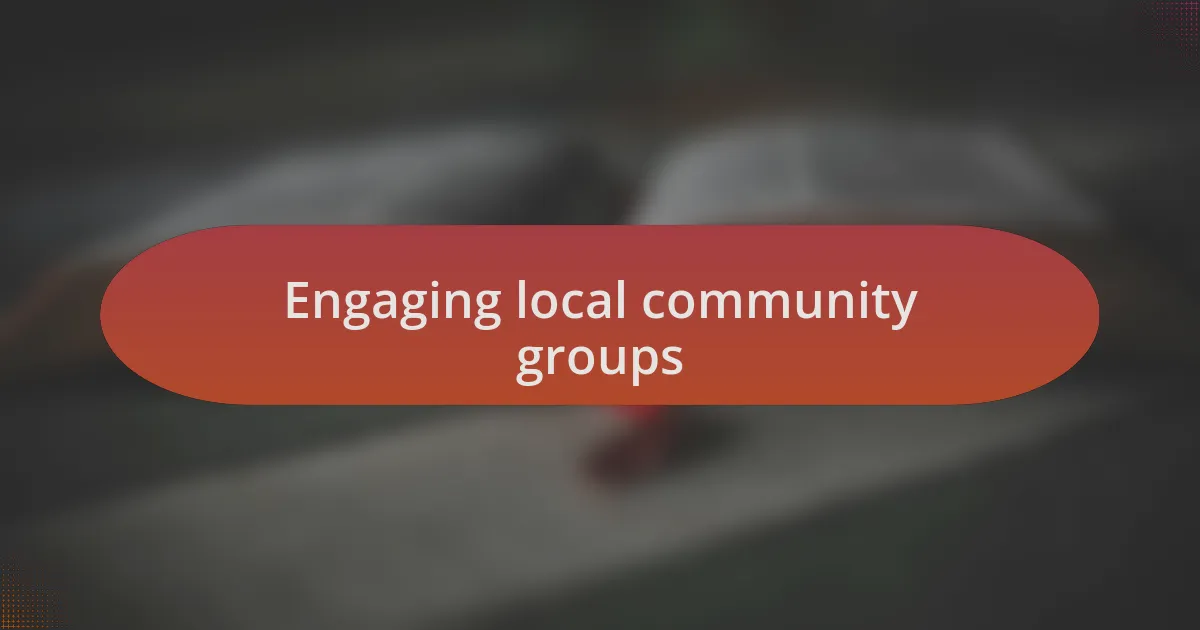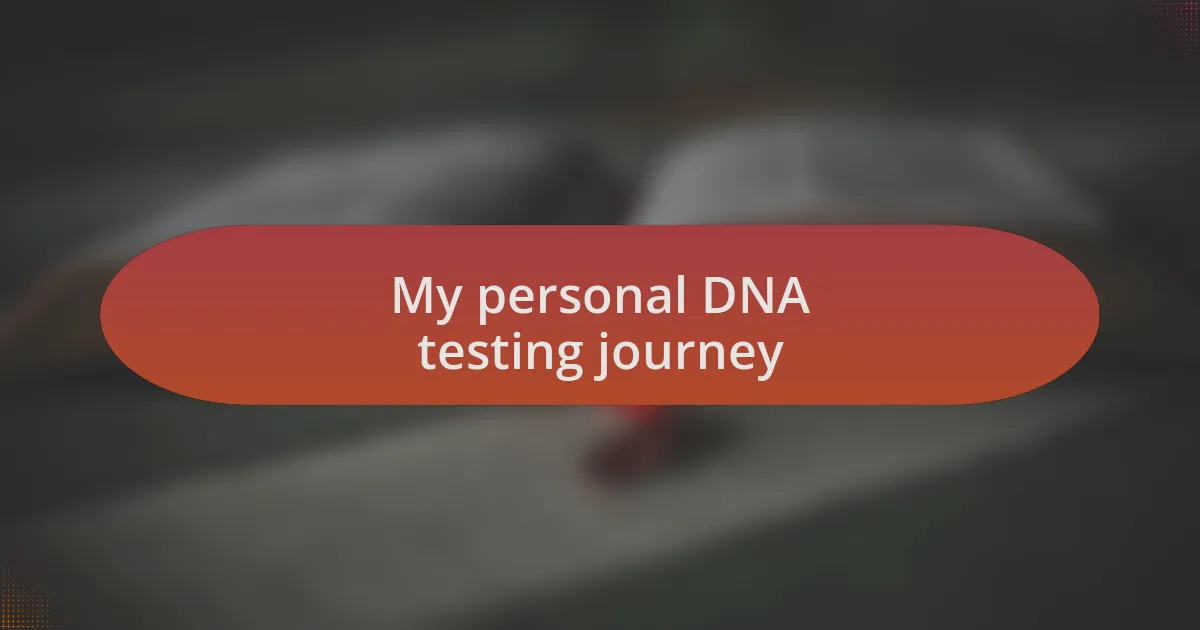Key takeaways:
- Genealogy and DNA testing reveal personal and communal histories, enriching our understanding of community connections and heritage.
- Sharing DNA results with family fosters unity, curiosity, and deeper discussions about ancestral ties.
- Engagement with local genealogy groups enhances the exploration of ancestry, creating bonds with like-minded individuals and facilitating exciting discoveries.
- DNA testing uncovers not only family connections but also potential health insights, empowering informed lifestyle choices across generations.

Understanding community and genealogy
Genealogy isn’t just about tracing bloodlines; it’s about discovering the stories that connect us to our communities. When I first dived into my family tree, I was astonished to uncover links to historical events that shaped my town. Have you ever wondered how your ancestors might have influenced the community you live in today?
As I connected with distant relatives through DNA testing, I found a shared sense of belonging that transcended mere ancestry. One cousin I discovered, who lives across the country, recounted tales of our shared great-grandparents that sparked a newfound pride in my roots. Isn’t it fascinating how these connections can transform not just our view of family but also our understanding of the places we call home?
Exploring genealogy has a way of weaving together the fabric of community life. I remember volunteering with a local historical society, where I met individuals passionate about preserving our town’s heritage. That experience made me realize: how often do we reflect on the profound impact of our shared histories on our present communities?

Benefits of DNA testing
DNA testing opens doors to new understanding within genealogy, revealing connections that often go beyond mere names on a family tree. For instance, when I received my results, I discovered relatives I had never heard of, leading to a thrilling virtual reunion. Have you ever felt that rush of excitement upon realizing you belong to a bigger family network?
Another remarkable benefit lies in the health insights provided by DNA tests. I wasn’t just learning about my lineage; I was also uncovering potential health risks linked to my ancestry. This knowledge empowered me to make healthier lifestyle choices and share vital information with family members, creating a shared responsibility for our well-being. Isn’t it astounding to think that something as simple as a DNA test could lead to better health for generations to come?
Moreover, engaging with my DNA results fostered a deeper appreciation for cultural heritage. More than just identifying ancestral regions, I began exploring traditions related to those cultures. I often ponder: how much richness does our heritage hold? With each discovery, I felt a renewed connection to my community, as I celebrated customs that have been passed down through generations.

How DNA testing works
DNA testing works by analyzing your genetic material, which is extracted from a simple saliva or cheek swab sample. When I first sent in my sample, I was both curious and nervous about what the lab would reveal. It felt like handing over a piece of my identity to science—what secrets would be unveiled?
Once the sample arrives at the laboratory, scientists isolate your DNA and examine specific markers. These markers help identify your genetic ancestry and can highlight potential connections to relatives based on shared segments of DNA. I’ll never forget the moment when I saw those family match notifications pop up—there was a thrill in discovering unknown cousins and branches that had previously been hidden from me.
Through this process, you also learn about your haplogroups—genetic populations that share common ancestors. When I dug into mine, it felt like tracing my roots back in time and space, almost like a treasure map leading me to distant lands. Have you ever wondered how your own history intertwines with that of those who came before you? It’s a question I now explore often, feeling a deeper bond with my heritage.

Choosing the right DNA test
Choosing the right DNA test is crucial for anyone looking to explore their ancestry. I remember my own deliberation over which company to choose; the options can be overwhelming. Should I focus on ethnicity estimates, or was connecting with living relatives more important to me? Ultimately, understanding what I hoped to learn guided my decision.
Each DNA testing service offers different features, which can profoundly influence your experience. For instance, some tests provide detailed information about your genealogical heritage, while others emphasize health insights, which I found intriguing. I initially leaned towards ancestry information, but as I considered my family’s health history, I realized that understanding genetic predispositions could be equally valuable.
As you evaluate your options, think about what outcome excites you most. Do you envision reconstructing your family tree or perhaps unraveling health mysteries that run in the family? For me, the allure of piecing together my lineage felt like embarking on a journey into forgotten stories. The right test can be a powerful tool to connect those stories to the present and help you engage more fully with your community and heritage.

Sharing results with family
Sharing my DNA results with family members was a pivotal moment in my journey. I vividly recall gathering everyone around the dinner table, transforming what typically felt like a mundane conversation into an exhilarating event. The excitement was palpable, and it led to deeper discussions about our ancestry that we had never touched upon before. How often do families really delve into the past together?
As I shared my findings, I could see the surprise on my relatives’ faces when we uncovered unexpected connections. Some results revealed distant cousins that none of us had ever known about, prompting spontaneous plans to reach out. This newfound information didn’t just enhance our family narrative; it sparked a sense of unity and curiosity that drew us closer together.
Bringing everyone along on this adventure was honestly fulfilling for me. I felt as if I was revealing hidden chapters of our family story, and the emotional connection was undeniable. It made me wonder, how many other families have forgotten stories waiting to be uncovered through such a simple act as sharing test results? In many ways, I felt like a storyteller, weaving together the threads of our shared heritage.

Engaging local community groups
Engaging with local community groups provided an exceptional opportunity to expand my understanding of genealogy. I remember attending a local history event where passionate individuals shared stories about their heritage, and I found myself immersed in discussions about how DNA testing can bridge gaps in family trees. Have you ever sat among strangers who quickly become friends over a shared love for ancestry? That sense of belonging was exhilarating.
I also joined a local genealogy society that organized workshops focused on interpreting DNA results. During one session, we collaborated on a presentation that highlighted our unique findings and their implications for our communities. It was inspiring to see how many stories emerged from simple test results, blending personal histories with broader community narratives. I couldn’t help but wonder how many adoptive families or immigrant stories are waiting to be explored through such collaborative efforts.
In another memorable instance, I hosted a DNA-sharing meetup at my home. Friends and neighbors brought their test results, and our discussions sparked a wave of enthusiasm for exploring lineage. Together, we unearthed exciting connections that, at times, even led to heartwarming reunions of long-lost relatives. How incredible is it to think that DNA has the power to bring people together, revealing relationships that might have otherwise remained unknown? The sense of community created in those moments was truly rewarding.

My personal DNA testing journey
My journey into DNA testing began with a mix of curiosity and skepticism. I decided to take the plunge after hearing about a friend’s discovery of a long-lost half-brother through testing. That revelation sparked a personal quest; could I uncover hidden branches of my family tree? When the results arrived, the anticipation was palpable. Each new piece of information felt like unlocking a door to the past, and I found myself reflecting on how my roots intertwined with the lives of others.
As I delved deeper into my ancestry, I encountered unexpected surprises. One match revealed a distant cousin with a shared love for the same obscure historical figure I had idolized since childhood. It was a strange thrill to connect over our shared passions, despite having grown up continents apart. This connection made me ponder—how many people out there might be waiting for a similar revelation? The thrill of these discoveries fueled my determination to not only trace my lineage but also to engage with those who were navigating their own ancestral paths.
I vividly recall a moment at a community DNA fair where I shared my results with others. The look of astonishment on a fellow participant’s face as he learned about his indigenous heritage was unforgettable. I felt honored to witness that shared excitement, sparking conversations that turned into friendships. It made me realize that DNA testing isn’t just about numbers or new family connections—it’s about sharing stories and forging bonds that might last a lifetime. Have you ever experienced that spark of kinship through shared histories? For me, it was the essence of what being rooted in community is all about.